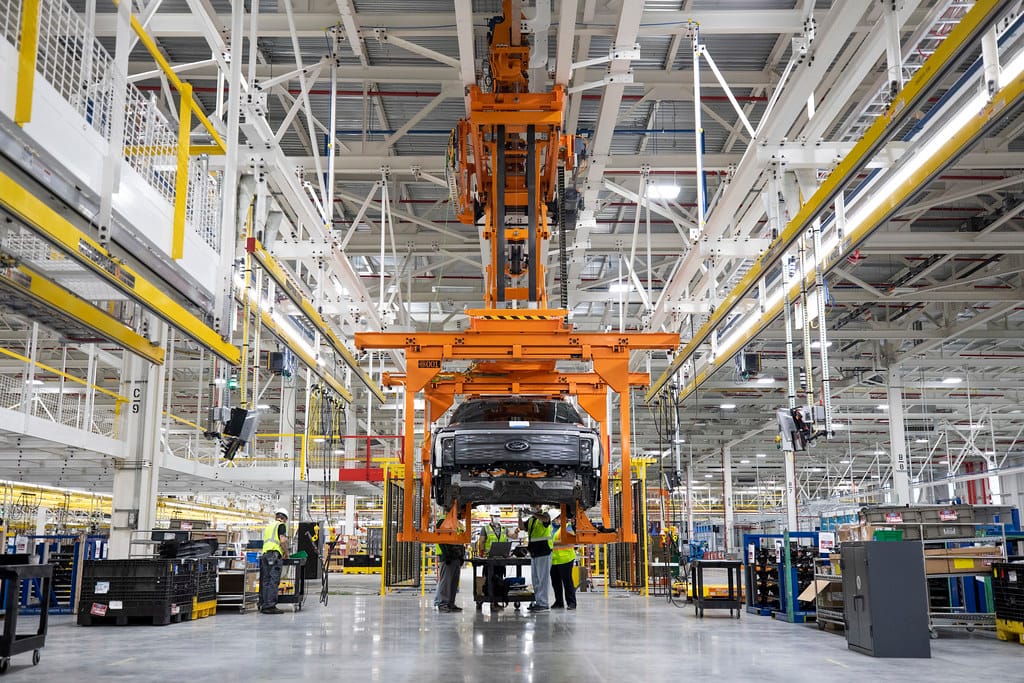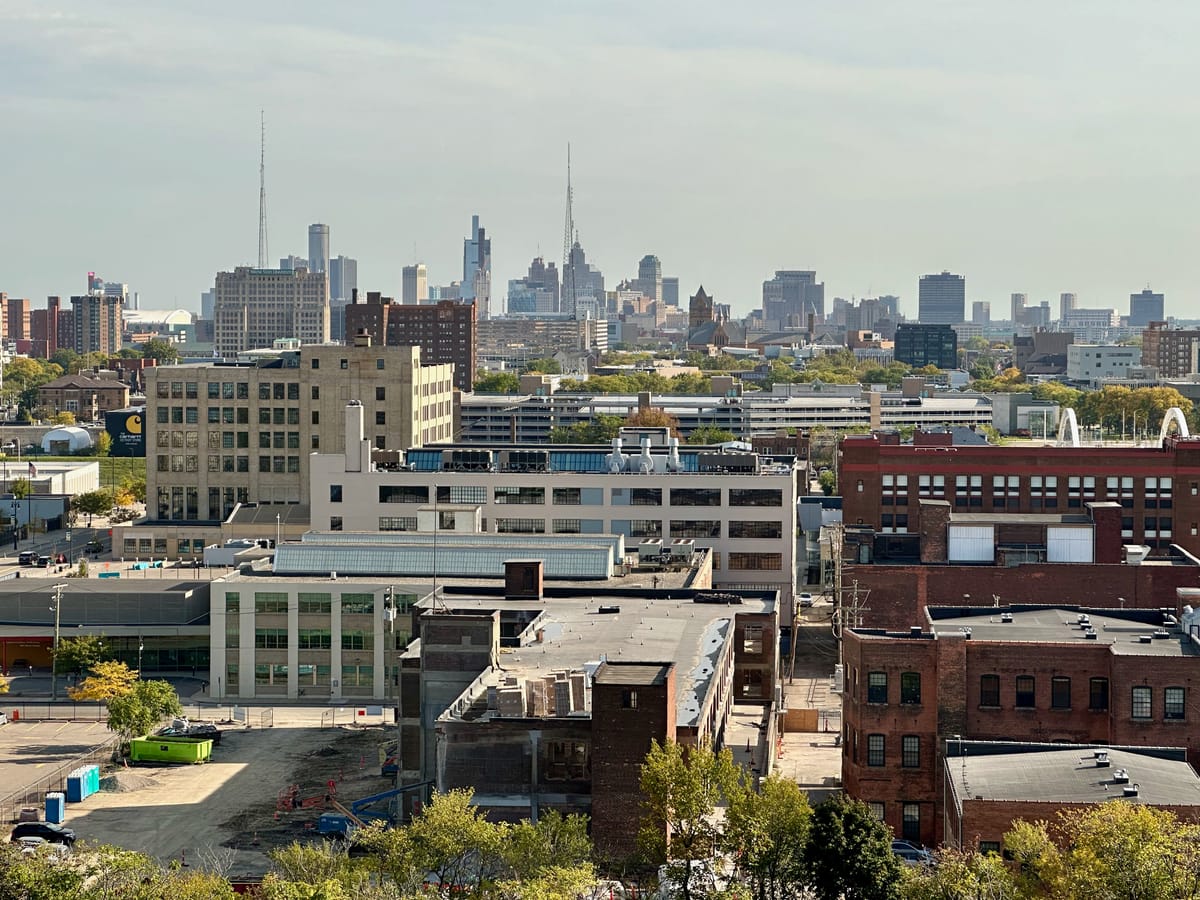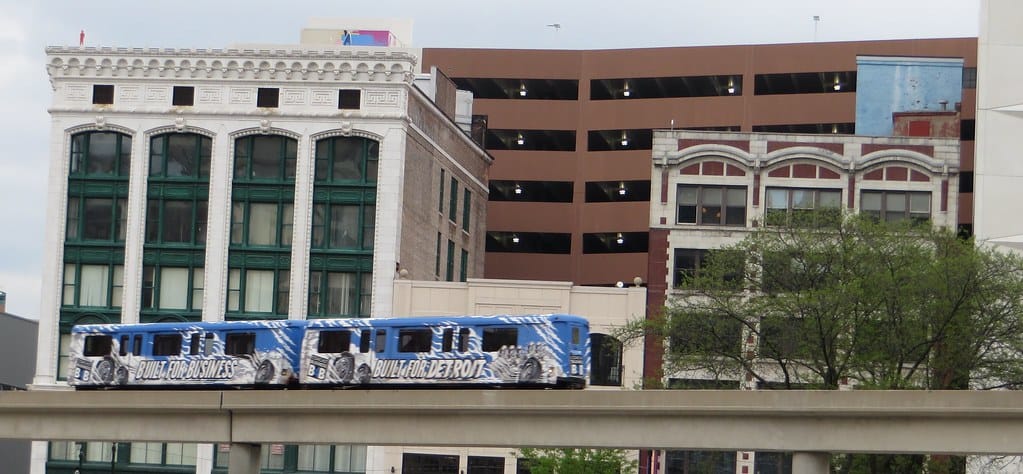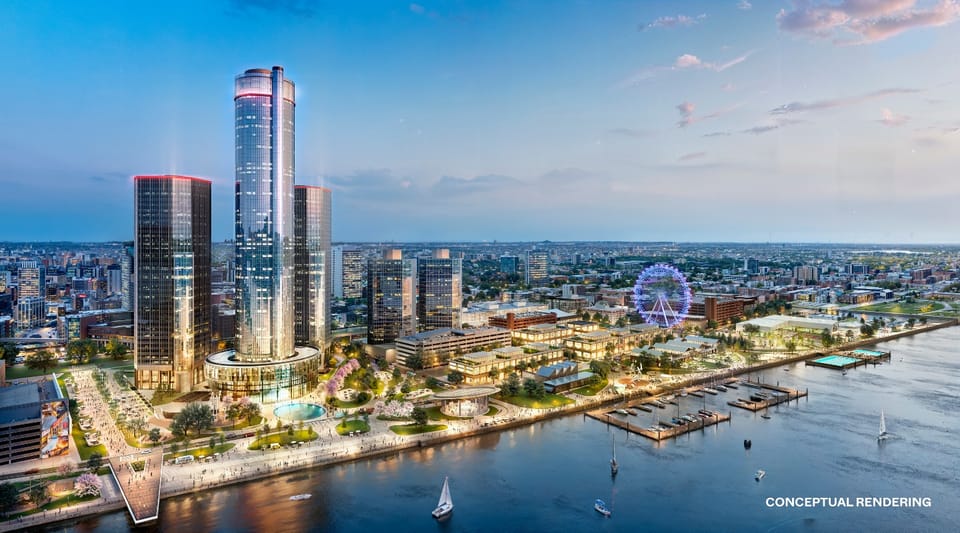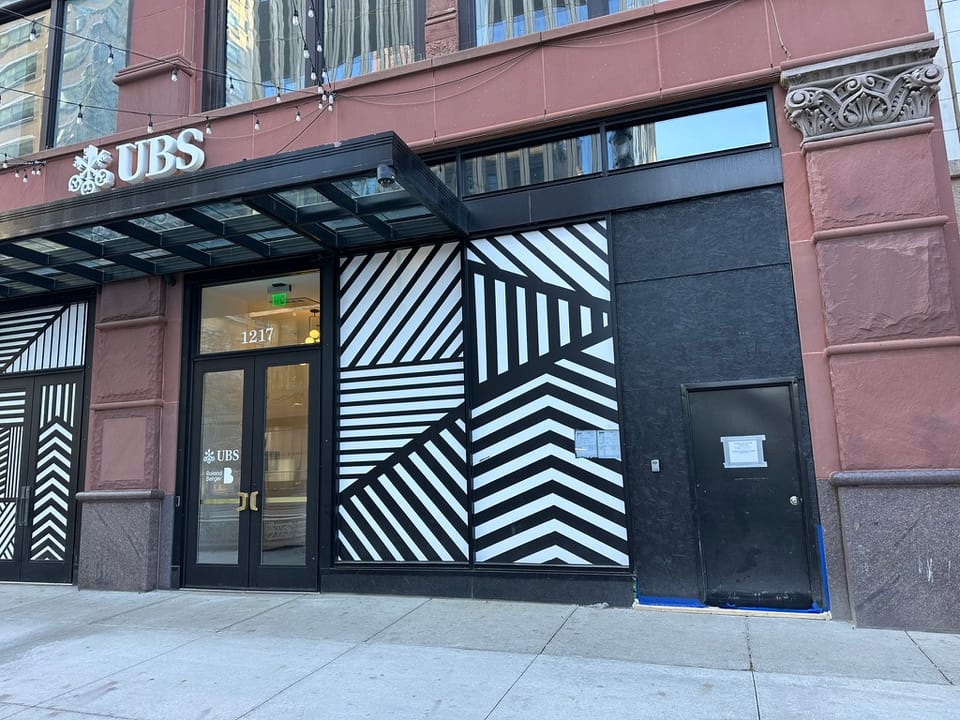The next Mayor of Detroit, whoever they are, will have some really big challenges from their budget to figuring out how to continue to draw investment, to trying to rebuild the city's middle class.
Anika Goss, the CEO of Detroit Future City, shares details on their new report "Opportunities for the Next Mayoral Administration to Grow Detroit’s Middle Class." You can read it here.
Below you'll find a full transcript of the conversation. Please refer to the original audio if you decide to quote it.
Feedback as always - dailydetroit - at - gmail - dot - com or leave a voicemail, 313-789-3211.
Transcript of the conversation with Anika Goss
Jer Staes: So what spurred you on to do this report?
Anika Goss: We felt like it was really important to create a brief, an outline, not only for the mayoral candidates, but also for Detroiters, mostly for Detroiters, to be able to ask hard questions, to be able to think about what they want their next candidate to focus on and how to really prioritize that.
A lot of times, a lot of these campaigns, it's all about, you know, the high point, high-level pitch talking points from candidates. And we really wanted to dig in as to what we thought was really important to Detroiters, from what we've heard from Detroiters.
Jer Staes: And to start this report out, you highlight a couple of, I don't want to say roadblocks, but challenges ahead that are real that maybe people haven't thought about that have been a big part of funding some of the things that have been happening in Detroit.
Anika Goss: That's right. The ARPA money that was a part of the Biden administration post-COVID to help cities and local communities was a huge tranche of federal funds, over a billion dollars that Detroit received, is running out and will run out in '26. In addition, the credit that we were receiving from the receivership will also end.
And so, there is a pretty big financial cliff that we will have to do a lot more with a lot less, 800 million less.
Jer Staes: That is a big cliff. And the reality is, on the ground, and I can say this as a city resident, the costs in the city are high.
A lot of these residents are already burdened in a lot of ways. You can't really go back to the well with, you know, the existing situation and raise additional revenue because…
Anika Goss: On taxes?
Jer Staes: Yeah, on taxes. Because I believe and you know different groups say different things, but I've heard that we're actually second only to New York City in cumulative tax rates.
Anika: Yeah. That's right. So, right. Exactly. Our tax rate actually needs to come down, especially property tax. And that's a hard proposition when we have not really worked at … when we still have so many tax foreclosures in Detroit and hardship propositions for many households that aren't able to pay their taxes, having a strong tax base is critical to that. So there has to be some balance in there.
Jer: So how does that tie to the middle class?
Anika: Yeah. So, I think, you know, what we outline is that there are some really specific issues that need to be addressed for the future of Detroit. So being the next mayor is going to be really tough. And how you attract investment in Detroit, how you consider new development and new business development in Detroit, all has to be able to work for Detroiters and really work for Detroiters, meaning that we have high, you know, really specific benchmarks for higher wages; really specific benchmarks for diversity of housing; a much easier pathway for small businesses and and enterprise businesses to be able to come into Detroit and invest much easier than we do now.
We have to make it easier to even intermediate access to capital, right? So financial institutions need to want to be able to invest in Detroit because this is a good place to do business. That's how you can begin to generate revenue. That's how you can begin to increase wages and make Detroit a place of opportunity for middle-class households.
Jer: So, what is the gap that we're staring at right now?
Anika: We're only about 25% of Detroiters are at the middle class. And we are trying to, or in that category between 62,000 and 150,000, which is how we've defined “middle class” based on the national median income. We really believe that Detroit, to be comparable with other communities in the region, we have to be somewhere in the area of 36% of Detroiters falling into that middle class category. That only really is about 32,000 residents either growing their income or moving to Detroit.
So it is a both-and situation. I want to be really crystal clear about that. That we're not making a proposition that this is a replacement proposition or a replacement proposal.
This has to be an opportunity. Detroit has to be a place where you can grow your income and raise your family right here in Detroit.
Jer: There's a myriad of challenges to make that happen. You know, you look at the data … the share of Detroiters with a bachelor's degree or higher is 19%, which I believe definitely lags behind the state and the nation.
Anika: That's right.
Jer: Although not every good paying job requires a degree, it definitely can help.
Anika: That's right.
Jer: I also think about access to training, access to work itself. Many times there are jobs in the city. But if I remember correctly, and this wasn't in the report, but if I remember correctly, I do believe that the majority of Detroiters are leaving the city to go to work, for employment.
Anika: For employment. Yes.
Jer: And so all this stuff ties together, and it feels complex, but you also lay out a number of policy priorities to try to say, “Okay, we can wrap our hands around this problem.”
Anika: We absolutely … we have to wrap our hands around this problem. We have to really take into consideration wealth-growing strategies for Detroiters that are here and really looking at neighborhoods and a neighborhood approach where there are amenities for households that want to stay in Detroit or move to Detroit.
Jer: So what are a few of the keystones toward that that you're that you've identified?
Anika: Yeah. So, we really have focused on things like mixed-income housing, diverse housing choices, right? So, not only affordable housing, but housing that meets at every income level and really focusing on a neighborhood strategy for that.
Small business and mid-sized business at the neighborhood level, really focusing on things like basic infrastructure and improvement of infrastructure. So, everything like reducing the risk of flooding and climate-related risks.
So, planting new trees and repairing sidewalks and other kinds, green stormwater management, managing infrastructure is a basic need for strong middle-class neighborhoods that we should focus on. But we also talk about things like having transportation and access to jobs and other amenities that might be outside that neighborhood. That also has to be a priority. These are some of the things that we'll have to fix.
And then some of the obvious things like the Duggan administration has done a really good job of addressing crime and safety and perceptions of crime and safety in a lot of these neighborhoods.
Detroit feels safer in most places all around the city, right? We have to maintain that. And a lot of that safety strategy … strategies were really predicated on community policing and police engaged in the neighborhood levels themselves.
Jer: I want to put a pin in the diversity of housing point that you made.
Anika: Yeah.
Jer: Because I think it's interesting since, you know, whether it's … whether it's online or in our emails, I feel like there's just a mass misunderstanding about what affordable housing is and what we need. Because so often it is focused only on the absolute poorest or maybe those who qualify for say Section 8 vouchers.
And there isn't really an understanding of the variety that's kind of needed for a variety of price points and then the variety of types. Like it's a multi-faceted conversation as opposed to … well, just things need to be as cheap as possible.
Anika: Right.
Jer: Right? And I understand that there's a frustration among some because especially when they look downtown, they'll see more luxury places being built.
Anika: Yeah. Higher income housing.
Jer: Right. But it's about how do you enable that mix?
Anika: Right, exactly. You have to have a mix of housing. You know, part of the biggest challenge is that the housing options are either very high because they're based on the area median income. So, in the neighborhoods where you're seeing the most development, they are using 80% of area, you know, 50 to 80% of area median income, which ends up being much higher than what the median income, the Detroit average income is, right?
So, in those neighborhoods where there's new development happening, it feels unaffordable.
It feels much, much more expensive, and rental rates are still very high. But then, in neighborhoods where you're not seeing development yet, the housing is, we're not seeing any other amenities there. It's … these are much more challenged, disinvested areas. Those places are still really affordable, but they're places that you may not want to live in right now, certainly not as a middle-class household.
So that's why there has to be sort of a diverse housing choice options throughout the city to actually create enough housing balance for lots of different families at different price points.
Jer: Are there any solutions that you have kind of looked at or seen?
Anika: You mean in other cities?
Jer: Yeah.
Anika: Yeah. We've seen, you know, Pittsburgh has some really interesting solutions where they used low-income housing tax credits, which is just a … it … that's the name of an affordable housing tool. And that, they use that tool in high market areas.
So they put low-income housing tax credit, which had income restrictions, next to market rate high-end housing because of an economic development, when Google, in the neighborhood that Google was moving into in Pittsburgh. And that has had a really … really strong effect because the low … the LITECH, the low-income housing tax credits actually hold the affordability for those units for 15 years.
You're also seeing examples in zoning where they're removing the single family residential zoning, and that allows for a lot of different mixes of housing units in a single neighborhood. So you can then have more affordable duplexes or quads in a neighborhood that was previously zoned for single family only.
Jer: So one of the things that I've noticed living in the city is that a lot of our housing stock is older, but it's from a different era. So I'll just use my own personal example. And I don't want to put a judgment on it. I'm just going to share what I have seen. I live in Detroit's North End.
Anika: Okay.
Jer: Beautiful homes, right? However, however, the homes that exist now, if you were to build them today, would be luxury housing. Oftentimes, there are some in the community or some that come through or whatever and say, "Well, we should build new…” like what we had.
You know, like to keep the continuity of the neighborhood. Like I wake up, I can see four lots out my back window that are empty, plus a burnt out grocery store, right? Like nothing has happened in a, there are things happening in the North End, but like there's a lot of abandonment around me.
Anika: Sure.
Jer: However, to rebuild, uh, the houses like they were, people don't realize like, we're talking five bedroom houses with two stories that today, that would be luxury housing.
Anika: Yeah.
Jer: So, how do you, like, I feel like that is attention of housing from a different era. You know, much of Detroit's housing wasn't updated. You talk about some of the neighborhoods that haven't seen development. Some of that stuff, I mean, I remember I volunteered with Motor City Blight Busters, and I've hand-demoed places. And it's like, nobody's buying a 700 square foot, you know, little match stick.
Anika: People shouldn't live like that. You know, I think there's some really interesting things that are happening with modular housing to deal with this issue. You know, 98% of Detroit housing was built before 1970. And so the affordable housing, or you know, the historic housing that we have, it's a real challenge.
It's, you know, because not only is it difficult to replace the housing so that it does fit within the aesthetic of the original neighborhood, it's also really difficult to maintain.
We are not considering modular at all as an option, but that might have to be an option. And you can actually design modular housing. It just means that it's factory built. It just … it's not stick built. It's not a trailer. Nobody's proposing a trailer park.
Jer: I recently wrote an editorial talking about that, wondering like, you know, we keep talking about places like the Packard plant for automotive services. What if we reimagined the Packard plant site to build housing? Because you can make the outside match a lot of these things. I've traveled to other cities, and I've seen some amazing things.
And I'm even thinking in my North End [neighborhood], right? You could make homes that look great, but maybe actually inside it's a duplex or a triplex, but from the front, it fits that character.
But it's about the design decisions that you make. It's about that intentionality that I would love to see here.
Anika: It fits. Yeah. They have brick exterior and all of that. So, yeah, that's been a … we have to get past that because that is a real option.
The cost of development is so high now in Detroit.
I mean, it's up to, I've heard numbers as high as $300 a square foot, which is enormous to try to subsidize that for an affordable housing unit. And so we have to be able to come up with options that will fit for all kinds of income points.
Jer: One small developer who does not do tons of projects, is not some billionaire, told me that it costs just as much to build in Chicago as it does Detroit, but you don't get the same rents.
Anika: Right. That's right.
Jer: And that's a major gap. One thing that is, I think sometimes difficult to talk about, but I think we should broach it a little bit is, you know, Detroit's lost a lot of its middle class. And a lot of that middle class is a Black middle class.
And so what about these kinds of programs helps, are you, are you hoping helps bring back some of that or attract?
Because, you know, Detroit is a super majority Black city. It's part of what makes it beautiful. It is an amazing thing. Like I choose to live here. I've known … like I choose to live here knowing that it is, right? I think that's part of the magic. So, you know, how do we get some of those people back? We're talking about tens of thousands of people.
Anika: I, you know, I … I don't know that we're going to convince some Detroiters to come back as much as I want to stop the bleed. We've lost 100,000 Detroiters just in 10 years. 100,000 Black Detroiters, middle-class Black Detroiters, because they can afford to move. They move all over the city.
If we can slow that down, and show the Detroiters that are here are choosing to stay. The Detroiters that will have a higher wage are choosing, there are options for them to stay right here. Maybe they move to a different neighborhood and that's the goal instead of the goal, the North Star is to move outside of Detroit. That's the expectation that I have.
If people start coming back, if we start to see covered wagons of Black Detroiters coming back in the city, I would love that, but I'm not … I'm not betting on that.
Jer: What is a policy point or two that could be pushed on to help encourage that?
Anika: Yeah. I mean, I think, I think the next mayor is going to have to really focus on great neighborhoods. Every 200. There are 220 census tracts in Detroit, which means there are more or less 200, more than 200 neighborhoods.
Every neighborhood in Detroit that's a residential neighborhood needs to be a place of middle-class opportunity, whether it is now or whether it is in the future.
The next mayor will have to be best friends with the school superintendent, Dr. Vitti. Because if they're not, in terms of developing a strategy to retain and grow middle-class households here in Detroit, we will continue to lose households with kids.
Jer: And a note for listeners, in case they don't know, unlike some major cities, the school district and the city administration are two separate things. In some places, the mayor oversees the schools. That is not the case here. It is two separate, two separate systems, two separate budgets, a lot of political history with that, similar in some ways to the library system.
We have a very independent library system. So that is something that maybe complicates things, but also sometimes, I think sometimes people get reticent to talk about the importance of schools because they go, "Well, I'm running for mayor. If I promise something for a thing that I don't control directly and get held accountable for it, that could be a bad thing." But I think we got to move past that.
Anika: We absolutely. It is imperative that we move past that.
We need a new benchmark for what our schools look like and that access to schools in every neighborhood, no matter where you are, is exceptional so that you will choose Detroit and a Detroit neighborhood and a Detroit school to raise your family and your children.
Jer: This is purely anecdotal, and that might be very annoying to a data person. There's so much beautiful data in this. But anecdotally, what I see among friends is, is if their kid starts going to school outside of the city,
Anika: Mm-hmm.
Jer: That's when the margin … like if they did stay in the city to school age, they'll be sending their kid to a district somewhere outside, and eventually there will be this, like, click that goes, this pull that says, "I just want to be near."
Anika: Yeah.
Jer: “I just want to be near where my kid's going to school, even just because it's just practical.” It's hard with a family trying to juggle everything. And I just have, I've seen it over and over again where it's like, oh, you know, some suburban district somewhere and all of a sudden they're out there within, within two years.
Anika: That's right. That's right. That's the way it works. I mean, we could go on and on, but, you know, schools, taxes, insurance, all of these things, the cost of living in Detroit.
Jer: Yes.
Anika: The Detroit tax, uh, is something that we have to really focus on so that Detroit is a great place for everybody.
Jer: I don't want to end this without talking about climate infrastructure.
Anika: Okay.
Jer: I know that our audience is very interested in the environment. So, uh, what are some of the things that we could do in Detroit to be climate resilient?
Anika: Yeah, you know, I mentioned earlier about, green stormwater infrastructure and really focusing on our water system, which is really tough, right? And it's this, this infrastructure, this aging infrastructure, the problem is that our aging infrastructure can't support climate changes, the climate impacts.
So, when we see these torrential rains, which used to be called 500 year rains or 1,000 year rains, meaning they only happen every 1,000 years, where you're getting eight to 10 inches of water, the the system, many, many parts of our water system, stormwater sewage system can't support that.
We have to be able to figure out how to work with the state, with the Great Lakes Water Authority and really develop strategies to be able to secure our stormwater system better.
That also includes partnering with DTE and really thinking about renewable energy differently, because our blackout rate is one of the highest in the country.
Jer: I went out and I bought my own battery, like one of those like camping batteries, because I literally lose my power for at least three days every single summer.
Anika: Well, and so you know what, that, that inability to be able to manage the grid in that way, that infrastructure, because it's also a climate problem, it's hotter, it gets hotter and that puts more pressure on the grid.
The grid upgrades are challenging because Detroiters aren't making enough money to pay the bills.
DTE can't raise the rates that they would need to actually upgrade the system so we would never have blackouts. They're doing the best they can, you know, upgrading here and there. They just upgraded in my neighborhood, but it requires a level of balance.
And we have to do that because that … because we've, we're in an administration … we're in an environment right now where we're not going to be focused on climate change for some time from the federal government.
So it's up to us to actually continue to address these issues in a much more aggressive way in order to make sure that our neighborhoods are safe and stable and climate resilient.
Jer: This whole thing is about the middle class. And I just can't help but think of an online creator that I follow called The Financial Diet [on YouTube], who sometimes like, “Hey, sometimes you just got to have more money in to make some things happen.”
And I feel like this is something that can really help Detroit in a lot of ways if the people of Detroit are just making more money and able to, you know, support themselves and also help support the system. Sometimes something … sometimes things just cost what they cost.
And if you don't have enough, you just can't afford it.
Anika: Right. And it's a tough conversation to have right now when we're still paying $12 for eggs.
Jer: Yeah.
Anika: And so, you know, when, when the, and the economy is not going to get better anytime, it's not going to get better, right? And so, for a while.
And so we have to be creative and intentional about how to make sure that Detroiters have opportunities to increase their wages wherever possible. Not only so that they can meet their basic needs, but so that they can move into the middle class and stay in Detroit.
Jer: Well, if people want to know more, where can they go?
Anika: www.detroitfuturecity.com. I think our report is up on the website on the front page right now. You can just click on it right there.
Jer: And I will put a link in the show notes.
Anika Goss, the CEO of Detroit Future City. Thank you so much, and please come back sometime!
Anika: Thank you for having me.

